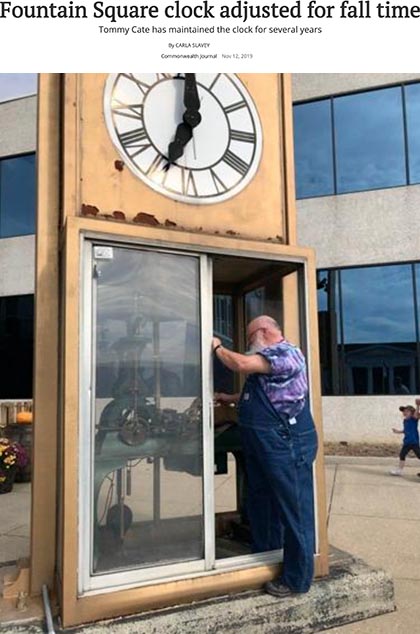
![]() Home
Home
![]()
![]() Schedule
Schedule
![]()
![]() Gospel Hour
Gospel Hour
![]()
![]() Videos
Videos
![]()
![]() Discography
Discography ![]()
![]() Interviews
Interviews
![]()
![]() Photos
Photos
![]()
![]() News & Reviews
News & Reviews
![]()
![]() Helpful Harmonica Stuff
Helpful Harmonica Stuff
![]()
![]()
![]() Contact:
Contact:
![]() tcate@holyharmonica.com
tcate@holyharmonica.com
Hillbilly Hippie Music Review
![]()
APPY Awards 2021
![]()
Master Musician 2021
![]()
APPY Awards 2022
![]()
KOGA: Robert G Alley Award 2022
![]()
Fountain Square Clock Adjusted for Fall Time

Tommy Cate, local geologist, adjusts the clock on the Fountain Square. The historic clock has to have its time changed by advancing the time forward, which can take time during the 'fall back' of changing from daylight saving to standard time.
On Monday afternoon, a little bit more than a week after the end of daylight saving time, Tommy Cate was out on the edge of the Fountain Square adjusting the time on the old clock that sits in the northeast corner.
He has to advance the hands hour-by-hour, he explained, because they can only move forward, not backwards.
"It's real easy when you 'spring forward,'" he laughed.
Cate continued: "You can adjust it in about four or five minute increments, so I'll get it close and get it a few minutes ahead, then shut the power off down here - " where he points to the wires the bring electricity into the base of the metal casing " - and let the time catch up with the clock. Then, I kick it back on again. I use to work real hard to keep it, literally, within seconds of being correct. If I can get it within a minute or so, I don't worry about it anymore. That's close enough."
Cate is the president of Fireborn Land & Energy, a geologist for the oil and gas business. His office is on the second floor of the Prather building, with the antique clock nestled in between that and the Citizens National Bank.
That means for years, Cate has looked out his office window and watched the clock, which is owned by the Pulaski County Government.
Cate said he would ask the former community development director for county government, Tiffany Finley, to find someone to adjust the clock when it was needed.
The first few times, she did, but eventually handed over the key to it. That was around eight or 10 years ago.
"The key hangs inside the door of my office. I've always got it," Cate said.
"I've kind of grown up around clocks, so it was not difficult [to figure out]," he said.
He praised the original craftsmanship - the clock was built by E. Howard & Co. and originally was part of the old Pulaski County Courthouse.
Cate likewise praised the late David Neal from Stanford, who converted the clock to what we see today. The clock first ran on a weight-and-pendulum system. When the old courthouse was torn down in the mid 1970s, the clock was relocated to the Fountain Square and switched to run on electricity.
"He did a fabulous job, by the way, of setting it up and getting the timing working right," Cate said.
"It keeps perfect time," he added. "When I used to keep it within four or five seconds of being exact, it would just hold it right there until I had to adjust it the next season. It was impressive."
The casing itself is seeing the affects of time, however. Cate points out the rust on top of the frame, saying it lets water inside.
"All the joints are rusted out, and it's just a shame. This is such an historic piece of equipment, and it's a shame to be letting this happen to it," he said.
He said he does his best to keep the rust off the clockwork and keep it well-oiled.
"It's really a unique piece of equipment, and it's kind of a privilege to get to take care of it."